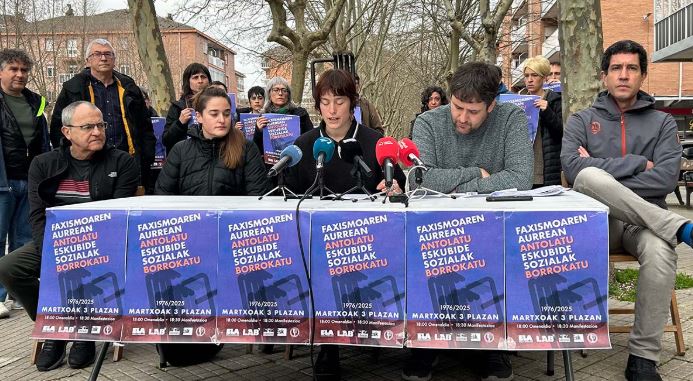Communists of the Perezagua battalion
- The Society of Aranzadi Sciences has exhumated the bodies of twelve people in the village of Etxaguen in Zigoitia. All the signs indicate that Facundo Perezagua could be one of the members of the communist battalion, who participated in numerous battles during the 1936 civil war.

Next to the church of Etxaguen, semi-hidden by a new road, Aranzadi has unearthed a pit in which remains of trees are found. This is the largest mass discovered so far in Euskal Herria, dedicated to the recovery of corpses from the civil war. The finding of the bones of twelve people has, however, led to the hypothesis of the researcher of Aranzadi Pako Etxeberria that there could be other remains. However, as in many other cases, not all exhibitors will be able to come to light, as the grave was semi-captured by a road built since 1936.
Aranzadi has been performing this type of excavation since 2000 and in recent years numerous remains have been recovered in the Basque Country and in Spain. However, anthropologist Lourdes Errasti, who works on these excavations, has explained to Hitza de Gipuzkoa that “it seems that this issue is at the end”, since people with information are being killed to find graves: “It’s imperative that someone give a clue, there’s the key,” says Errasti.
In Zigoitia, the neighbours have always known that in that place the fascists buried the bodies of several people, something that has been secretly said inside the houses. Recently, the priest Félix Placer and the president of the administrative board of Etxaguen, Marisol Hernando, contacted the institutions and took the initiative. The work of archaeologists began and ended on April 4.
The exposed bones may belong to militiamen who died in the battle of Legutiano in December 1936. In the fight of Gutileano, left and Abertzales participated, with the aim of reaching Vitoria-Gasteiz, a city dominated by Francoists. But they did not manage to pass through Legutiano and had many deaths in the area; the lack of experience has been mentioned in explaining this failure.
Aranzadi believes that the remains exposed in Etxagune could correspond to the members of the communist battalion Facundo Perezagua, who were buried upside down, “like atheists”, in the words of Placer. Between the bones, several pencils and coins have also appeared.
Perezagua Battalion
Perezagua was one of the 25 battalions fighting in Legutiano. It was founded in the summer of 1936, formed mainly by the Communists of the mining area. He participated in the battle of Legutiano, in the area of Otxandio, where many colleagues were killed.
Later, in February 1937, they were transferred to Asturias, within the Basque brigades formed by the Government of Agirre to attack the city of Oviedo. The members of Perezosa managed to dominate a strategic peak, but there also failed the general operation, with the disaster of the village of Areces being the most known event of that battle, the murder of Commander Candido Saseta.
In the summer of 1937 the Perezagua battalion was virtually destroyed, many local militiamen had died or been arrested. However, the communists of Perezosa joined another battalion and continued to fight until in August 1937 they gave in to the Italians in Santoña, with thousands of other soldiers. On 4 September, when the Santoña prisoners were held by the Francoists, the first person to be shot was Bilbaíno Manuel Egidazu Garai, commander of the battalion Facundo Perezagua.
Kirola eta oroimena uztartuko dituzte, bigarrenez, mendi-martxa baten bitartez. Ez da lehiakorra izanen, helburua beste bat delako. La Fuga izeneko mendi martxak 1938ko sarraskia gogorarazi nahi du. Ezkabako gotorlekuan hasi eta Urepelen amaituko da. Maiatzaren 17an eginen dute.
Fusilamenduak, elektrodoak eta poltsa, hobi komunak, kolpismoa, jazarpena, drogak, Galindo, umiliazioak, gerra zikina, Intxaurrondo, narkotrafikoa, estoldak, hizkuntza inposaketa, Altsasu, inpunitatea… Guardia Zibilaren lorratza iluna da Euskal Herrian, baita Espainiako... [+]
Gogora Institutuak 1936ko Gerrako biktimen inguruan egindako txostenean "erreketeak, falangistak, Kondor Legioko hegazkinlari alemaniar naziak eta faxista italiarrak" ageri direla salatu du Intxorta 1937 elkarteak, eta izen horiek kentzeko eskatu du. Maria Jesus San Jose... [+]
Familiak eskatu bezala, aurten Angel oroitzeko ekitaldia lore-eskaintza txiki bat izan da, Martin Azpilikueta kalean oroitarazten duen plakaren ondoan. 21 urte geroago, Angel jada biktima-estatus ofizialarekin gogoratzen dute.
Bilbo Hari Gorria dinamikarekin ekarriko ditu gurera azken 150 urteetako Bilboko efemerideak Etxebarrieta Memoria Elkarteak. Iker Egiraun kideak xehetasunak eskaini dizkigu.
33/2013 Foru Legeari Xedapen gehigarri bat gehitu zaio datozen aldaketak gauzatu ahal izateko, eta horren bidez ahalbidetzen da “erregimen frankistaren garaipenaren gorespenezkoak gertatzen diren zati sinbolikoak erretiratzea eta kupularen barnealdeko margolanak... [+]
1976ko martxoaren 3an, Gasteizen, Poliziak ehunka tiro egin zituen asanbladan bildutako jendetzaren aurka, zabalduz eta erradikalizatuz zihoan greba mugimendua odoletan ito nahian. Bost langile hil zituzten, baina “egun hartan hildakoak gehiago ez izatea ia miraria... [+]
Memoria eta Bizikidetzako, Kanpo Ekintzako eta Euskarako Departamentuko Memoriaren Nafarroako Institutuak "Maistrak eta maisu errepresaliatuak Nafarroan (1936-1976)" hezkuntza-webgunea aurkeztu du.

























